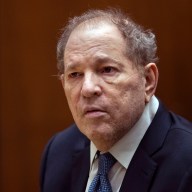 This is one of Chris Arnade’s favorite photos he has taken. The woman pictured, Deja, works as a prostitute in Hunts Point. Credit: Chris Arnade
This is one of Chris Arnade’s favorite photos he has taken. The woman pictured, Deja, works as a prostitute in Hunts Point. Credit: Chris Arnade
“I was even more driven to go when people told me not to go. They said it was New York’s most dangerous neighborhood and blah blah blah, all those things.”
This is how Chris Arnade described the genesis of his relationship with Hunts Point in the Bronx, one of the city’s poorest neighborhoods.
“I was really captured by the place,” he said.
Arnade was a bond trader on Wall Street until about a year ago. Now he spends his days—and nights—documenting the residents of some of the city’s toughest neighborhoods. Arnade has produced hundreds of portraits from Hunts Point, often of New Yorkers many are inclined to look away from.
 Barbara “has been prostituting in Hunts Point for close to 35 years,” Arnade said. She doesn’t use drugs and “would never call herself a victim.” Credit: Chris Arnade
Barbara “has been prostituting in Hunts Point for close to 35 years,” Arnade said. She doesn’t use drugs and “would never call herself a victim.” Credit: Chris Arnade
Photography has been Arnade’s lifelong passion, from crafting pinhole cameras as a kid to building small cameras in optics classes as a physics grad student. When he moved to New York, photography was his “outlet for stress,” he said.
That stopped around 1999 or so, he said, when digital took over.
“I didn’t like digital,” Arnade said. “It became harder and harder to use film so I stopped for basically seven or eight years.”
Then the financial crisis hit and, working on Wall Street, he found himself “more stressed than usual and with a little more free time than usual.” He turned to his former stress reliever, and started exploring the city again with a camera.
Around 2010, he started going to the Bronx.
“I had just kind of run out of places to go and my curiosity drove me to there,” he said.
That’s when he “stumbled into Hunts Point.”
He would work on Wall Street from 6 in the morning until 6 at night and then head out to Hunts Point. He started leaving work earlier, sometimes as early as 3 p.m., to spend more time there. Eventually, about a year ago, he left his job as a bond trader.
“I’m still very fond of Wall Street,” he said. “I think it’s gotten a bad rap in a lot of ways. I think there are a lot of wonderful people who work there. But the industry itself over the course of my time there decayed and… became something much different than when I entered.”
He spent more and more time in Hunts Point, and eventually was approached by some of the prostitutes and addicts he was seeing there. One of the prostitutes, Takeesha, started talking to him and he was struck by her wit and humor.
“I was kind of upset that what I saw in terms of who she was and as I got to know her better was so much different than what the press reported on addicts,” he said. “You know, she was, to put it bluntly, as smart and clever and hard-working and interesting and fun as anybody I knew on Wall Street.”
“Yet her backstory was atrocious.”
Takeesha was raped at age 10 or 11, then put out on the street by her mother, also a prostitute, at the age of 11 or 12.
 Takeesha and Deja marvel at the rings of Saturn as seen through a telescope Chris Arnade brought up to Hunts Point. Credit: Chris Arnade
Takeesha and Deja marvel at the rings of Saturn as seen through a telescope Chris Arnade brought up to Hunts Point. Credit: Chris Arnade
This is not an uncommon story among the prostitutes and addicts he has befriended in Hunts Point. And his portraits achieve what the press reports he criticized did not: they show addicts and prostitutes as individuals with personalities, with histories. They show the humanity of Hunts Point, beyond the dire statistics on poverty and addiction.
“I’m a little bit naive in the sense that I honestly believe that if you go into a meeting with somebody and you don’t judge them and you treat them as equals no matter who they are, they will respond to that,” Arnade explained, describing how he was welcomed into the community. “They’ve told me this themselves: a lot of the access I got with the addicts was I didn’t come in there thinking I was going to tell them what to do, I didn’t come in there thinking I was going to save them, which is an offensive idea.”
Find more of Chris Arnade’s photography and storieshere.
Follow Danielle Tcholakian on Twitter: @danielleiat















